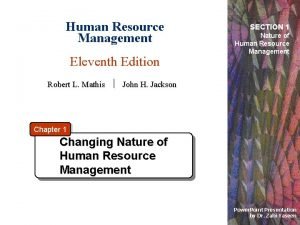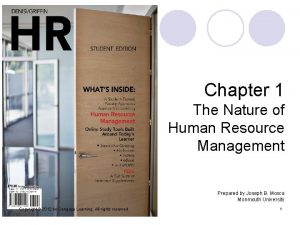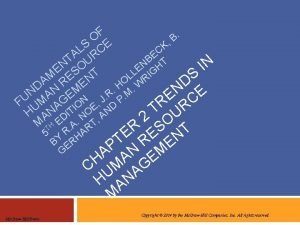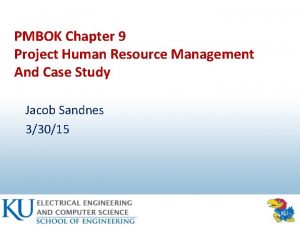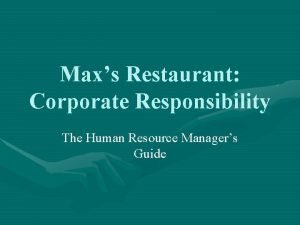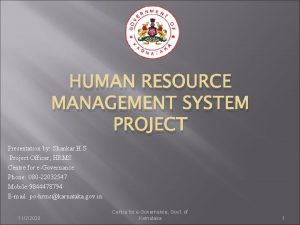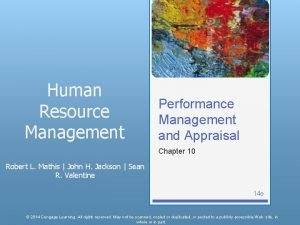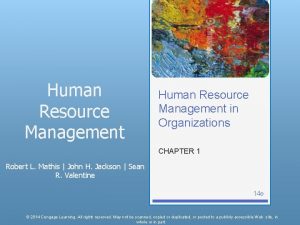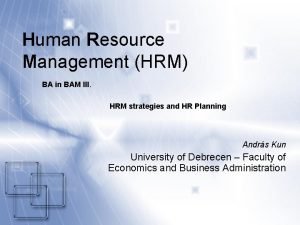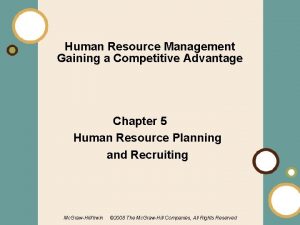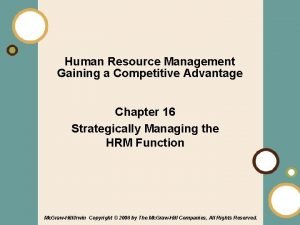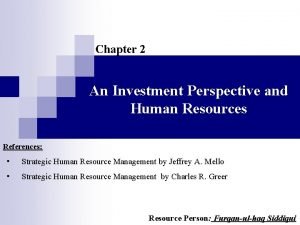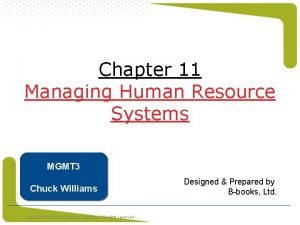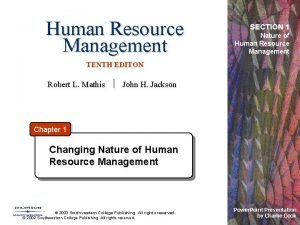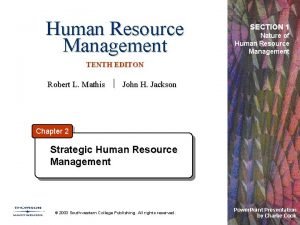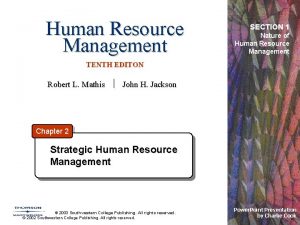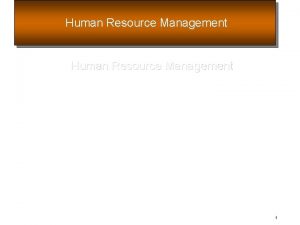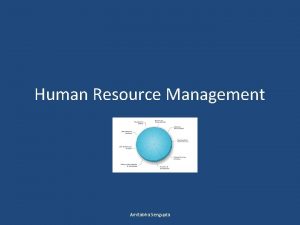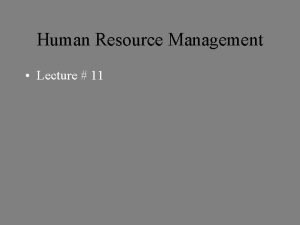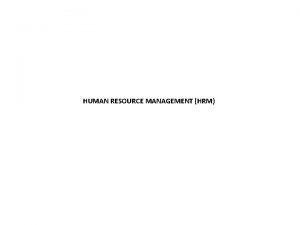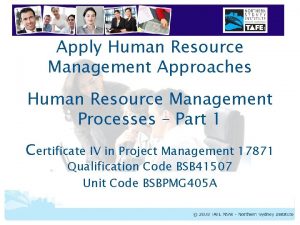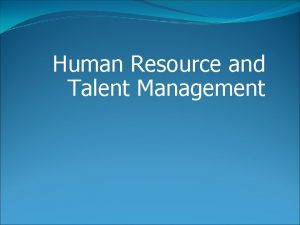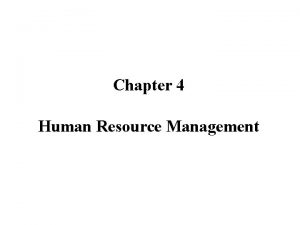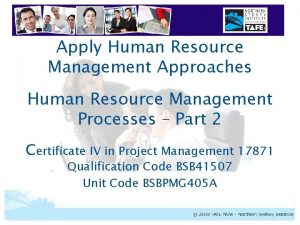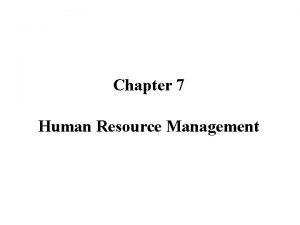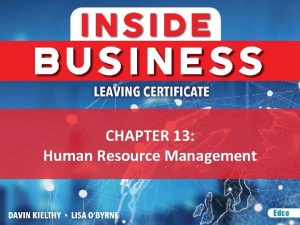Human Resource Management SECTION 1 Nature of Human





























- Slides: 29

Human Resource Management SECTION 1 Nature of Human Resource Management TENTH EDITON Robert L. Mathis John H. Jackson Chapter 3 Individual Performance and Retention © 2003 Southwestern College Publishing. All rights reserved. © 2002 Southwestern College Publishing. All rights reserved. Power. Point Presentation by Charlie Cook

Learning Objectives After you have read this chapter, you should be able to: – Discuss how motivation is linked to individual performance. – Identify the changing nature of the psychological contract. – Describe several types of absenteeism and turnover. – List the five major retention determinants and identify activities related to them. – Outline the retention management process and how to measure and assess turnover. © 2002 Southwestern College Publishing. All rights reserved. 2

Individual Employee Performance § Individual Performance Factors – Individual ability to do the work – Effort level expended – Organizational support Performance (P) = Ability (A) x Effort (E) x Support (S) © 2002 Southwestern College Publishing. All rights reserved. 3

Components of Individual Performance Figure 3– 1 © 2002 Southwestern College Publishing. All rights reserved. 4

Individual Motivation § Motivation – The desire within a person causing that person to act to reach a goal. § Maslow’s Hierarchy of Needs – Categories of needs that ascend in order; lower needs must be fulfilled before person will strive to meet higher needs. • • • Physiological needs Safety and security needs Belonging and love needs Esteem needs Self-actualization needs © 2002 Southwestern College Publishing. All rights reserved. 5

Individual Motivation (cont’d) § Herzberg’s Motivation/Hygiene Theory – Motivators—account for job satisfaction and motivation • Achievement • Recognition • Work itself • Responsibility • Advancement – Hygiene factors—cause dissatisfaction with work • Interpersonal relationships • Company policy/administration • Supervision • Salary • Working conditions © 2002 Southwestern College Publishing. All rights reserved. 6

Equity as a Motivator § Equity – The perceived fairness of what the person does compared to what the person receives. – The perception of the fair value of rewards (outcomes) for efforts (inputs) that individuals make when comparing their results to others in the organization. © 2002 Southwestern College Publishing. All rights reserved. 7

Expectancy Theory § Expectancy – Individuals base decisions about their behaviors on their expectations that one or another behaviors is more likely to lead to needed or desired outcomes. – Effort-to-Performance Expectations • Belief in the ability to perform the task well – Performance-to-Reward Linkage • Belief that high performance will result in receiving rewards – Value of Rewards • The rewards have value to the individual © 2002 Southwestern College Publishing. All rights reserved. 8

Simplified Expectancy Model of Motivation Figure 3– 2 © 2002 Southwestern College Publishing. All rights reserved. 9

Management Implications for Motivating Performance § The need for comprehensive strategies and tactics to address both equity and expectations of employees. § The provision of training to encourage high performance. § The development of evaluation methods that properly appraise and reward performance. § An understanding of what kinds of rewards are desired and valued by employees. © 2002 Southwestern College Publishing. All rights reserved. 10

Individual/Organizational Relationships § The Psychological Contract – The unwritten expectations employees and employers have about the nature of their work relationships. Affected by age of employee and changes in economic conditions. – Employers provide: • Competitive compensation and benefits • Career development opportunities • Flexibility to balance work and home life – Employees contribute: • Continuous skill improvement • Reasonable time with the organization • Extra effort when needed © 2002 Southwestern College Publishing. All rights reserved. 11

Job Satisfaction and Organizational Commitment § Job Satisfaction – A positive emotional state resulting from evaluating one’s job experience. § Organization Commitment – The degree to which employees believe in and accept organizational goals and desire to remain with the organization. © 2002 Southwestern College Publishing. All rights reserved. 12

Factors Affecting Job Performance and Organizational Commitment Figure 3– 3 © 2002 Southwestern College Publishing. All rights reserved. 13

Job Satisfaction and Organizational Commitment § Absenteeism – Involuntary absenteeism • Unavoidable with understandable cause (e. g. , actual illness) – Voluntary absenteeism • Avoidable without justifiable cause (e. g. , feigning illness) – Measuring absenteeism © 2002 Southwestern College Publishing. All rights reserved. 14

Reasons for Unscheduled Absences Source: Based on data from CCH Absenteeism Survey, CCH Human Resources Management, November 1, 2000. © 2002 Southwestern College Publishing. All rights reserved. Figure 3– 4 15

Job Satisfaction and Organizational Commitment © 2002 Southwestern College Publishing. All rights reserved. 16

Job Satisfaction and Organizational Commitment § Turnover – The process in which employees leave the organization and have to be replaced. § Types of Turnover – Involuntary turnover—terminations for poor performance or work rule violations. – Voluntary turnover—employee leaves the organization by choice. © 2002 Southwestern College Publishing. All rights reserved. 17

Job Satisfaction and Organizational Commitment © 2002 Southwestern College Publishing. All rights reserved. 18

Retention of Human Resources § Impact of Retention Failure – Inability to achieve business goals – Loss of “image” to attract other individuals – High costs of turnover and replacement © 2002 Southwestern College Publishing. All rights reserved. 19

Retention of Human Resources § Why People Stay – Great company • Value and culture, well-managed, and offers exciting challenges – Great job • Freedom and autonomy, exciting challenges, and career advancement and growth – Compensation and lifestyle • Differentiated pay package, high total compensation, geographic location, and respect for lifestyle © 2002 Southwestern College Publishing. All rights reserved. 20

Most Common Reasons Why Employees Voluntarily Leave Source: Based on 2000 SHRM Retention Practices Survey (Alexandria, VA: Society for Human Resource Management, 2000). Permission requested. © 2002 Southwestern College Publishing. All rights reserved. Figure 3– 5 21

Retention Determinants Figure 3– 6 © 2002 Southwestern College Publishing. All rights reserved. 22

Desired Organizational Characteristics Source: The Right Communiqué, First Quarter 2001, 7. Used with permission © 2002 Southwestern College Publishing. All rights reserved. Figure 3– 7 23

Work Schedule Flexibility Source: Based on 2000 SHRM Retention Practices Survey (Alexandria, VA: Society for Human Resource Management, 2000). Permission requested. © 2002 Southwestern College Publishing. All rights reserved. Figure 3– 8 24

The Retention Management Process Figure 3– 9 © 2002 Southwestern College Publishing. All rights reserved. 25

The Retention Management Process § Measuring Turnover – Ways in which to measure turnover • • • § Job and job levels • Department, units, and location Reason for leaving • Length of service Demographic characteristics Education and training Knowledge, skills and abilities Performance ratings/levels Computing the turnover rate: © 2002 Southwestern College Publishing. All rights reserved. 26

Simplified Turnover Costing Model Figure 3– 10 © 2002 Southwestern College Publishing. All rights reserved. 27

The Retention Management Process § Costs of Turnover – Hiring costs –Training costs – Productivity costs –Separation costs § Employee Surveys – Attitude survey—focuses on employees’ feelings and beliefs about their jobs and the organization. § Exit Interviews – An interview in which individuals are asked to identify reasons for leaving the organization. © 2002 Southwestern College Publishing. All rights reserved. 28

The Retention Management Process § Retention Interventions – Provide realistic job previews during the recruiting process – Improve the selection process so that there is a better person-job fit for new hires – Conduct effective job orientation and initial training – Offer competitive, fair, and equitable compensation – Provide an adequate benefits package – Offer career development and training – Engage in fair and nondiscriminatory employee relations © 2002 Southwestern College Publishing. All rights reserved. 29
 Nature of personnel management
Nature of personnel management Nature of hrm
Nature of hrm Nature of human resource management
Nature of human resource management Time management human resources
Time management human resources Retail organisation
Retail organisation Defintion of hrm
Defintion of hrm Resource management pmp
Resource management pmp Resource management pmbok
Resource management pmbok Importance of ihrm
Importance of ihrm Human resource management in restaurants
Human resource management in restaurants Purpose of induction
Purpose of induction Hrm chapter 2
Hrm chapter 2 Chapter 9 human resource management
Chapter 9 human resource management Human resource management system project
Human resource management system project Performance appraisal in human resource management
Performance appraisal in human resource management Current issues in human resource management
Current issues in human resource management Ba human resource management
Ba human resource management Purpose of human resource management
Purpose of human resource management Human resources management gaining a competitive advantage
Human resources management gaining a competitive advantage Downsizing
Downsizing Human resource management gaining a competitive advantage
Human resource management gaining a competitive advantage Exam questions on human resource development
Exam questions on human resource development Management fifteenth edition
Management fifteenth edition Human resource management 15th edition
Human resource management 15th edition Gary dessler human resource management
Gary dessler human resource management Human resource management strategy and analysis
Human resource management strategy and analysis Investment perspective of hrm
Investment perspective of hrm Chapter 11 human resource management
Chapter 11 human resource management New approaches to organizing hr
New approaches to organizing hr Human resources introduction
Human resources introduction
